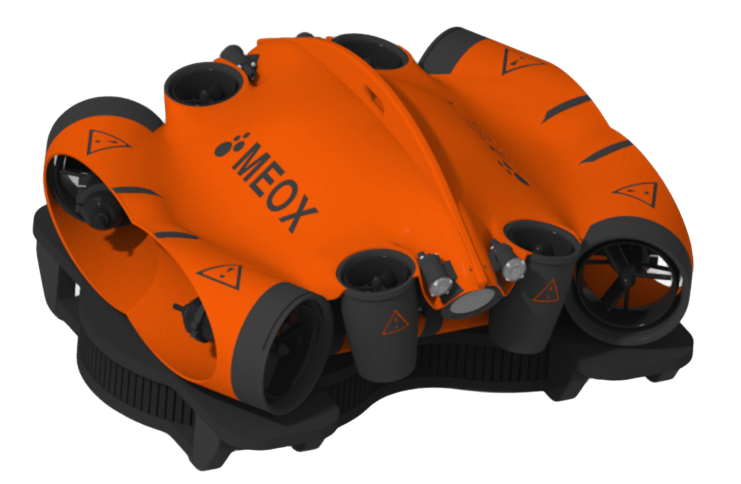Precision orientation and stabilization to enable safe and efficient underwater cleaning and inspection.
Introduction
Underwater environments present some of the toughest challenges for robotics:
- In aquaculture, fouled nets can restrict water flow, increase disease risk, and even cause costly fish escapes.
- In shipping, hull fouling reduces efficiency and raises fuel costs.
Thus, reliable cleaning and inspection is fundamental. But operating in dark waters, filled with debris, is certainly no easy task.
That’s where Meox, a Norwegian robotics company, comes in. With a decade of experience in underwater systems, Meox develops robots that can clean, inspect, and handle mortality events for fish farms and shipping operators.
At the core of their innovative products is the Xsens MTi-3 AHRS, providing the precise orientation and stabilization needed to make underwater work possible.
About Meox
Founded in Norway in 2015, Meox began by developing environmental monitoring sensors for fish farms. As demand grew for safer and more efficient ways to maintain underwater infrastructure, the company shifted its focus to robotics.
Today, Meox operates with a core team of seven, supported by specialized partners. Their product portfolio includes:
- Axuda Ray – high-performance net cleaner with patented cavitation technology. See here the Axuda Ray in action.
- Multiflex – a modular, multi-purpose ROV for net cleaning, hull cleaning, and underwater inspections.
- Vision – compact inspection ROV with advanced manoeuvrability.
- Scout – mortality-handling robot designed to remove dead fish quickly and hygienically.
Despite their compact size (some units measuring only 80 cm wide), these robots deliver powerful cleaning and inspection capabilities, reducing downtime and safeguarding both equipment and livestock.

The Axuda Ray from Meox cleans nets using cavitation cleaning
The Underwater Challenges
Traditional net maintenance in aquaculture required bringing heavy nets to the surface for cleaning, which is a time-consuming and costly process. Onsite cleaning with high-pressure washers improved efficiency but risked damaging net coatings and accelerating wear.
Operating robots underwater also come with additional challenges:
- Navigation without GPS – underwater, operators have little or no visibility.
- Harsh environments – debris, barnacles, and particles cause wear on motors and thrusters.
- Precise orientation required – cleaning effectiveness depends on stable heading and positioning.
For Meox, solving these challenges meant finding a reliable, compact, and cost-effective inertial sensor for orientation and stabilization.
The Solution – Xsens MTi-3 AHRS
Since 2024, Meox has integrated the Xsens MTi-3 AHRS into its net and hull cleaning robots, as well as new mortality-handling systems.
The connection was made possible through Link Nordic, Xsens’ distribution partner in Scandinavia, who recognized that Meox’s navigation and stability challenges could be addressed with Xsens orientation technology. Working closely with Meox, they facilitated the adoption of the MTi-3, helping Meox kick off integration quickly and effectively.
The MTi-3 provides:
- Stabilization – maintaining heading and orientation during operation.
- Operator guidance – giving reference points in low-visibility conditions.
- Approximate positioning – when combined with depth sensors, helps locate position within circular fish cages.
- Flexible deployment – used in both monitoring (full stabilization) and cleaning (heading-only stabilization).

The Meox Multiflex used the Xsens MTi-3 for orientation and stabilization.
According to Einar Agnalt, Development Manager at Meox, the MTi-3 stood out as the best suited solution during their testing:
“We tried several sensors and the MTi-3 was the best fit. It’s small, affordable, and easy to integrate. The quaternion support made orientation reliable, which is critical underwater.”
Benefits & Results
By equipping its robots with the MTi-3, Meox achieved:
- Improved reliability – stable heading ensures consistent cleaning results.
- Ease of integration – seamless communication protocols and quick adoption.
- Compact size (12 × 12 mm) – fits easily into both small (80 cm) and large (2.4 m) robotic platforms without design compromises.
- Cross-platform use – the same sensor works across net cleaners, hull cleaners, and mortality-handling robots.
- Enhanced operator confidence – orientation data compensates for low or no visibility environments.
- Customer value – reduced operational downtime, extended equipment lifespan, and healthier aquaculture environments.
Looking Ahead
Meox continues to expand its portfolio with innovative robots for aquaculture and shipping. The company is now developing automated mortality-handling solutions and enhancing inspection capabilities, with the MTi-3 serving as a trusted orientation sensor across all platforms.
Future plans include refining heading stability and collaborating with Xsens engineers to optimize sensor performance.
Conclusion
By combining patented cavitation cleaning technology with Xsens MTi-3 orientation sensing, Meox has set a new standard for underwater robotics in aquaculture and shipping. Their robots help operators maintain cleaner nets and hulls, safeguard fish welfare, and reduce costs, while the MTi-3 proves the reliability of Xsens technology in the harshest conditions.
This collaboration was made possible through Link Nordic, Xsens’ trusted partner in the Nordic region, who connected Meox with Xsens technology and continues to support customers across Scandinavia.